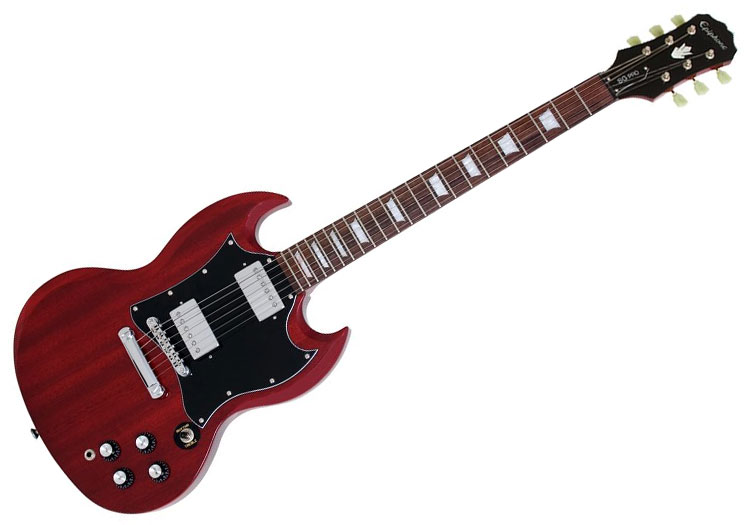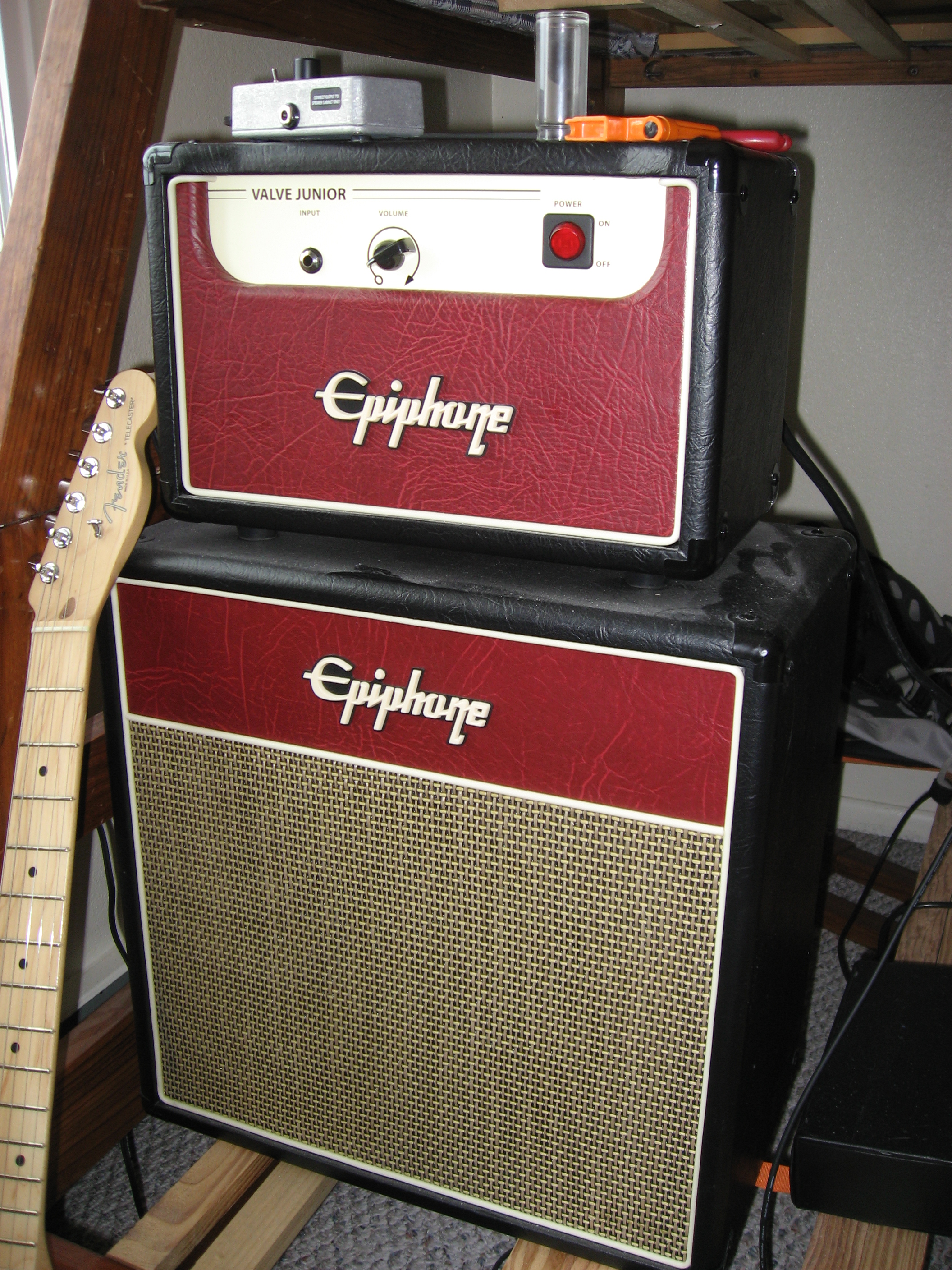|
Epiphone G-400
The G-400 (or sometimes G400) is an Epiphone solid body electric guitar model produced as a more modestly priced version of the famous Gibson SG. Currently, Epiphone is a subsidiary of Gibson and manufactures the G-400 and other budget models at a lower cost in Asia. Visually and ergonomically, it is almost identical to a 1962 SG. History Introduced in 1989 after Epiphone production moved to Korea in cooperation with the Samick Corporation, the G-400 has been in continuous production for thirty years. Upon introduction, it featured dot fretboard inlays, two open-coil humbuckers, green key tuners with the Epiphone logo stamped on their backs, a differently shaped truss rod cover with "Gibson" printed vertically, black "speed" knobs, and "narrow-open Book" headstock. By 1990, the G-400 was sporting the modern "clipped-ear" headstock with no holly inlay1990 Epiphone Catalog In 1996, several features of the G-400 were changed. These changes included black "top hat" knobs with silv ... [...More Info...] [...Related Items...] OR: [Wikipedia] [Google] [Baidu] |
Epiphone
Epiphone is an American musical instrument brand that traces its roots to a musical instrument manufacturing business founded in 1873 by Anastasios Stathopoulos in Smyrna, Ottoman Empire, and moved to New York City in 1908. After taking over his father's business, Epaminondas Stathopoulos named the company "Epiphone" as a combination of his own nickname "Epi" and the suffix " -phone" (from Greek ''phon-'', "voice") in 1928, the same year it began making guitars. In 1957 Epiphone, Inc. was purchased by Gibson, its main rival in the archtop guitar market at the time. Gibson relocated Epiphone's manufacturing operation from its original Queens, New York, factory to Gibson's Kalamazoo, Michigan, factory. Over time, as Gibson moved its own manufacturing operations to other facilities, Epiphone followed suit; Gibson has also subcontracted the construction of Epiphone products to various facilities in the US and internationally. Today, Epiphone is still used as a brand for the Gibson com ... [...More Info...] [...Related Items...] OR: [Wikipedia] [Google] [Baidu] |
Machine Head
A machine head (also referred to as a tuning machine, tuner, or gear head) is a geared apparatus for tuning stringed musical instruments by adjusting string tension. Machine heads are used on mandolins, guitars, double basses and others, and are usually located on the instrument's headstock. Other names for guitar tuners include pegs, gears, machines, cranks, knobs, tensioners and tighteners. Non-geared tuning devices as used on violins, violas, cellos, lutes, older Flamenco guitars and ukuleles are known as friction pegs, which hold the string to tension by way of friction caused by their tapered shape and by the string pull created by the tight string. Construction and action Traditionally, a single machine head consists of a cylinder or capstan, mounted at the center of a pinion gear, a knob or "button" and a worm gear that links them. The capstan has a hole through the far end from the gear, and the string is made to go through that hole, and is wrapped around the c ... [...More Info...] [...Related Items...] OR: [Wikipedia] [Google] [Baidu] |
Epiphone SG G-400 Electric Guitar With EMG Pickups (Alpine White)
Epiphone is an American musical instrument brand that traces its roots to a musical instrument manufacturing business founded in 1873 by Anastasios Stathopoulos in Smyrna, Ottoman Empire, and moved to New York City in 1908. After taking over his father's business, Epaminondas Stathopoulos named the company "Epiphone" as a combination of his own nickname "Epi" and the suffix " -phone" (from Greek ''phon-'', "voice") in 1928, the same year it began making guitars. In 1957 Epiphone, Inc. was purchased by Gibson, its main rival in the archtop guitar market at the time. Gibson relocated Epiphone's manufacturing operation from its original Queens, New York, factory to Gibson's Kalamazoo, Michigan, factory. Over time, as Gibson moved its own manufacturing operations to other facilities, Epiphone followed suit; Gibson has also subcontracted the construction of Epiphone products to various facilities in the US and internationally. Today, Epiphone is still used as a brand for the Gibson comp ... [...More Info...] [...Related Items...] OR: [Wikipedia] [Google] [Baidu] |
Mother Of Pearl
Nacre ( , ), also known as mother of pearl, is an organicinorganic composite material produced by some molluscs as an inner shell layer; it is also the material of which pearls are composed. It is strong, resilient, and iridescent. Nacre is found in some of the most ancient lineages of bivalves, gastropods, and cephalopods. However, the inner layer in the great majority of mollusc shells is porcellaneous, not nacreous, and this usually results in a non-iridescent shine, or more rarely in non-nacreous iridescence such as ''flame structure'' as is found in conch pearls. The outer layer of cultured pearls and the inside layer of pearl oyster and freshwater pearl mussel shells are made of nacre. Other mollusc families that have a nacreous inner shell layer include marine gastropods such as the Haliotidae, the Trochidae and the Turbinidae. Physical characteristics Structure and appearance Nacre is composed of hexagonal platelets of aragonite (a form of calcium carbona ... [...More Info...] [...Related Items...] OR: [Wikipedia] [Google] [Baidu] |
Flamed Maple
Flame maple (tiger maple), also known as ''flamed maple'', ''curly maple'', ''ripple maple'', ''fiddleback'' or ''tiger stripe'', is a feature of maple in which the growth of the wood fibers is distorted in an undulating chatoyant pattern, producing wavy lines known as "flames". This effect is often mistakenly said to be part of the grain of the wood; it is more accurately called "figure", as the distortion is perpendicular to the grain direction. Prized for its beautiful appearance, it is used frequently in the manufacturing of fine furniture and musical instruments, such as violins, guitars, and bassoons. During the westward expansion of early settlers and explorers into the lands west of the Appalachian Mountains, curly maple was often used for making the stocks used on Kentucky rifles. Usage in guitars Popularization Flame maple is especially popular in guitars, and has been for decades. Generally, the process includes cutting the maple to shape, forming it if necessary th ... [...More Info...] [...Related Items...] OR: [Wikipedia] [Google] [Baidu] |
Mahogany
Mahogany is a straight-grained, reddish-brown timber of three tropical hardwood species of the genus ''Swietenia'', indigenous to the AmericasBridgewater, Samuel (2012). ''A Natural History of Belize: Inside the Maya Forest''. Austin: University of Texas Press. pp. 164–165. . and part of the pantropical chinaberry family, Meliaceae. Mahogany is used commercially for a wide variety of goods, due to its coloring and durable nature. It is naturally found within the Americas, but has also been imported to plantations across Asia and Oceania. The mahogany trade may have begun as early as the 16th century and flourished in the 17th and 18th centuries. In certain countries, mahogany is considered an invasive species. Description The three species are: *Honduran or big-leaf mahogany ('' Swietenia macrophylla''), with a range from Mexico to southern Amazonia in Brazil, the most widespread species of mahogany and the only genuine mahogany species commercially grown today. Illegal l ... [...More Info...] [...Related Items...] OR: [Wikipedia] [Google] [Baidu] |
EMG, Inc
EMG, Inc. is the current legal name of a company based in Santa Rosa, California, Santa Rosa, California that manufactures guitar pickups and Equalization (audio), EQ accessories. Among guitar and bass accessories, the company sells active humbucker pickups, such as the EMG 81, the EMG 85, the EMG 60, and the EMG 89. They also produce passive pickups such as the EMG HZ, EMG-HZ Series, which include SRO-OC1's and SC Sets. There is also a series geared towards a more traditional and passive sound known as the X series. Their active pickups are most popular among hard rock and metal (music), metal artists such as Metallica, Slayer, Zakk Wylde, Sepultura, Judas Priest, Exodus (American band), Exodus, Emperor (band), Emperor, Cannibal Corpse, Children of Bodom, Death Angel, Cryptopsy, Malevolent Creation and Primus (band), Primus but also used by others such as Prince (musician), Prince, Vince Gill, Kyle Sokol, Steve Winwood, Steve Lukather and David Gilmour. History The company was ... [...More Info...] [...Related Items...] OR: [Wikipedia] [Google] [Baidu] |
Tony Iommi
Anthony Frank Iommi () (born 19 February 1948) is a British musician. He co-founded the pioneering heavy metal band Black Sabbath, and was the band's guitarist, leader and primary composer and sole continuous member for nearly five decades. Iommi was ranked number 25 in ''Rolling Stone'' magazine's list of the "100 Greatest Guitarists of All Time". On his last day of work in a sheet metal factory, as a teenager, Iommi lost the tips of the middle and ring fingers of his right hand in an accident, an event which crucially impacted his playing style. He briefly left Black Sabbath (then known as Earth) in 1968 to join Jethro Tull, but did not record any material with the band, and subsequently returned to Black Sabbath in 1969. In 2000, he released his first solo album '' Iommi'', followed by 2005's '' Fused'', which featured his former bandmate Glenn Hughes. After releasing ''Fused'', he formed Heaven & Hell, which disbanded shortly after the death of Ronnie James Dio in 2010. ... [...More Info...] [...Related Items...] OR: [Wikipedia] [Google] [Baidu] |
Gibson SG Special
The Gibson SG Special is an electric guitar made by Gibson that has been manufactured since 1961. Origins The SG Special was between the Junior and Standard model and was introduced concurrent with the Junior. It featured two P-90 pickups with either a stoptail bridge or an optional Vibrola. On this mid-level SG model, Gibson kept the neck binding but used dot inlays in place of the trapezoid position markers of the standard model and did not use the crown inlay on the headstock. With various minor changes (bridge and tailpiece replacing the stoptail in 1972, mini humbucker pickups between 1972 and 1976 and full sized open-coil humbuckers thereafter) the model has remained in continuous production. The influence of the P90-equipped SGs of the late 1960s and later reissues (such as the more recent SG classic—a modern reissue of the late 1960s SG Special) have spanned the rock genre and have notably been played by the likes of Pete Townshend (The Who: late-1960s SG Specials), To ... [...More Info...] [...Related Items...] OR: [Wikipedia] [Google] [Baidu] |
Pick Up (music Technology)
A pickup is a transducer that captures or senses mechanical vibrations produced by musical instruments, particularly stringed instruments such as the electric guitar, and converts these to an electrical signal that is amplified using an instrument amplifier to produce musical sounds through a loudspeaker in a speaker enclosure. The signal from a pickup can also be recorded directly. Most electric guitars and electric basses use magnetic pickups. Acoustic guitars, upright basses and fiddles often use a piezoelectric pickup. Magnetic pickups A typical magnetic pickup is a transducer (specifically a variable reluctance sensor) that consists of one or more permanent magnets (usually alnico or ferrite) wrapped with a coil of several thousand turns of fine enameled copper wire. The magnet creates a magnetic field which is focused by the pickup's pole piece or pieces. The permanent magnet in the pickup magnetizes the guitar string above it. This causes the string to generate a ... [...More Info...] [...Related Items...] OR: [Wikipedia] [Google] [Baidu] |




.jpg)

_(cropped)2.jpg)
